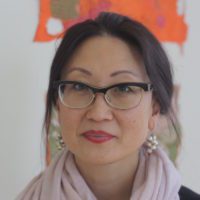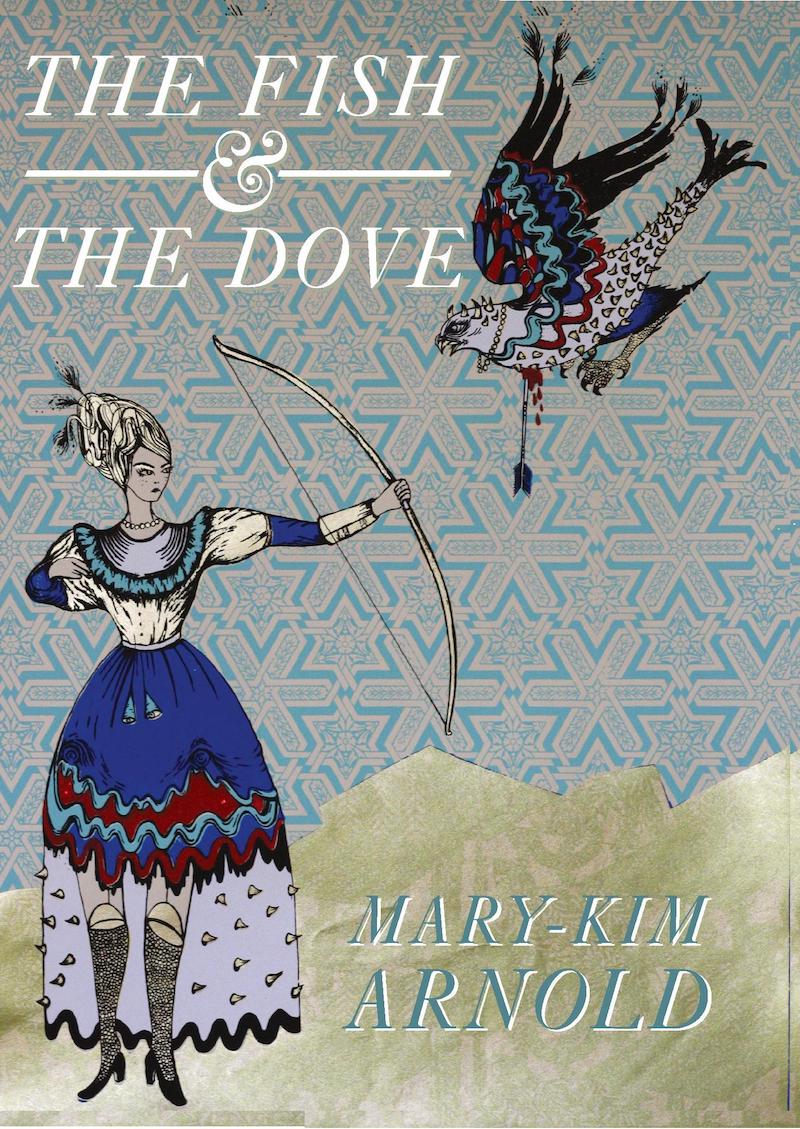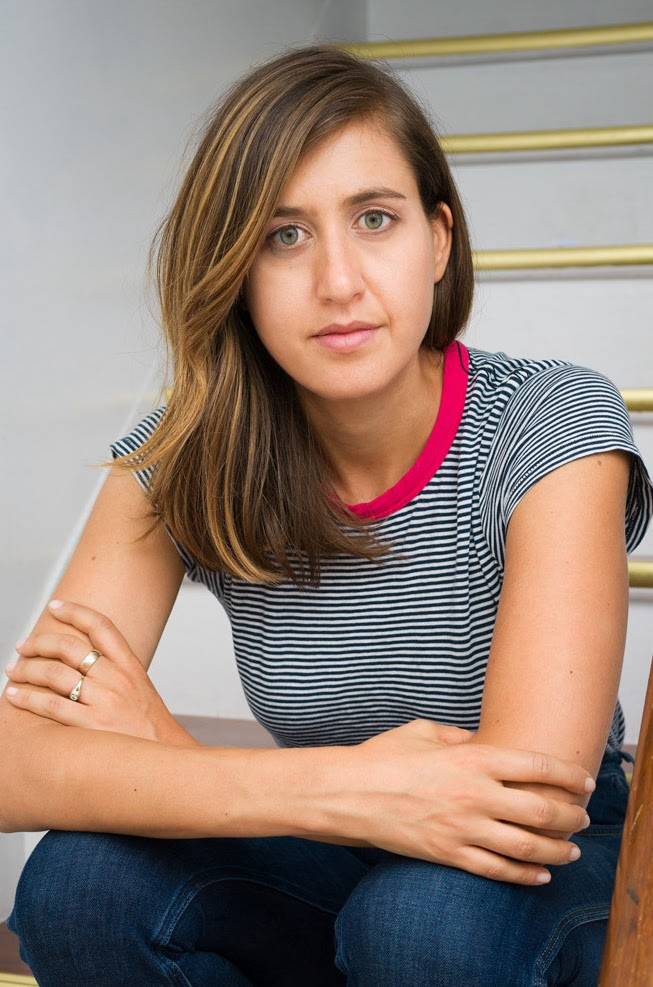The Rumpus Poetry Book Club chats with Mary-Kim Arnold about her new collection The Fish & The Dove (Noemi Press, April 2020), launching a book in the middle of a pandemic, Semiramis, self-portraits, and the violence of museum collections.
This is an edited transcript of the book club discussion. Every month the Rumpus Poetry Book Club hosts an online discussion with the book club members and the author, and we post an edited version online as an interview. To join the Rumpus Poetry Book Club, click here. Upcoming poets include Ariel Francisco, Heather McHugh, Thea Matthews, Benjamin Garcia, Sumita Chakraborty, Vijay Seshadri, Molly Spencer, and more!
This Rumpus Poetry Book Club interview was edited by Brian Spears.
***
Brian S: So, I have a ton of questions about the book, but let me start by asking what it’s been like, outside of surreal, to try to launch a book in our current environment?
Mary-Kim Arnold: I hear you. It all feels so bad. It’s hard to know what to worry about first.
Oh right, the book.
Brian S: Look, I spent the day today asking, “is it allergies or is it the virus?
Mary-Kim Arnold: Ha, totally.
Brian S: That’s a fun game to play every single day.
Mary-Kim Arnold: To be honest, I haven’t even really tried to launch the book. I just feel so weird and anxious and distracted. People have been great—inviting me to do online readings. I’ve been grateful for that, but I don’t feel much like promoting it? I mean, I’m proud of the book, I worked hard on it, I’m glad it’s done, but I don’t feel like I know what to do.
Brian S: I hear you. And I’m glad there are people out there with energy to do that work, but I am absolutely not one of them right now. Honestly, I’m having trouble picking up books just to read them.
Mary-Kim Arnold: I feel totally the same. I know a few people who are launching books, and it’s not that I think they shouldn’t—I think they absolutely should! But for me, it’s been really hard to muster much energy for it. I think I will, eventually, and I think eventually, I will want to. I really do want to support Noemi Press as much as I can—I feel in some ways like the promotional stuff is not about me, but about trying to make sure the work the press did is acknowledged and recognized. And thinking about that helps!
Yes, I find reading hard, too. I have about a half hour in the early morning that I can concentrate—before I get sucked into the news of the day—and I try to read a little then.
Brian S: Well, let’s do some work for Noemi here—I’ve been a huge fan of the press for a really long time—and talk about your book. What made you choose Semiramis as an integral figure for this book?
Mary-Kim Arnold: Well, it was a little bit serendipitous. In many ways, this book grew out of some of the thinking and reading I was doing for my first book, which really focused on my failed search for my birth mother, and what it meant to be an orphan, the idea of lineage, and so forth and at one point I was looking around for orphan figures in myth and legend and I stumbled across Semiramis.
I loved the bits of conflicting myth that I could find about her—her mother was a goddess, her father a mortal— but there were also these stories about her being an actual woman who ruled Babylon during a time of tremendous expansion. I was intrigued by trying to reconcile these bits of information and mythology
Brian S: It’s a name I had heard for a really long time but once I started reading your book, I realized I knew absolutely nothing about her except her name.
Mary-Kim Arnold: Well, there isn’t really that much about her—and what is available conflicts. Which I also thought was really interesting. (And my disclaimer here is that I am no historian, and can’t say my research methods were comprehensive.) But I was also doing some of the work on this book in the year leading up to the 2016 election and so the way women were talked about in terms of leadership, and what they could do, the places they could go—all of that was on my mind a lot, too—so this figure—who was also possibly this great warrior—was really intriguing. The fact that we know very little about her is also telling, I think. Or at least, it felt like a provocation for me, for writing.
Brian S: Yeah, the attempts to minimize a woman’s ability and success are always there. That’s never gone away, unfortunately.
Mary-Kim Arnold: Right. And of course, the question of the way women are represented (or not) in war histories, war narratives also felt relevant to me—most immediately in the Korean War, but more broadly, too. War is so often talked about and written about as if military combat is the only activity or effect of it. But of course, there are many legacies of war, many victims.
Brian S: Like in your poem “Silence” with the lines, “All the girls wore men’s clothes / because they didn’t want to get raped // All the girls did hard work / because the men were not around.” That’s a part of war that still doesn’t get talked about enough, though we’re seeing it more now than we have in the past.
Mary-Kim Arnold: Yes, right.
Brian S: And when it comes to the Korean War in particular, well, most Americans don’t know anything about anything. It’s M*A*S*H reruns if anything.
Mary-Kim Arnold: Right, right. And of course, for me, it was a really important starting point because there’s a way in which my story begins there—not directly, but in the aftermath of war, and in the relationship between US and Korea. “Orphan” and “woman” in that context feel similarly powerless, similarly used for other ends.
Brian S: One of the things I really appreciated about this book was that while there were moves toward the geopolitical issues between the US and Korea, the poems were more about, well, you and your own relationship with Korea. It moved the experience away from this big, cold picture to an equally big, but much hotter one. As in emotionally hot.
Like, it’s easy to be overwhelmed by geopolitics and just walk away from it, especially if you’re white, but this was about family relationships in the context of this much larger, violent struggle.
Mary-Kim Arnold: Oh, thank you for saying that, I like that description. I feel like the “women and war” thoughts I was having sort of yielded to an examination of what it means to be a (Korean American) girl, a (Korean American) woman in the US like, my experience of it. These things felt related. And I also wanted to acknowledge and “claim” (for the lack of a better word) an American girlhood, because I am, after all, that, too.
Brian S: Right, although I’m sure there have been plenty of people who’ve been willing, eager even, to tell you otherwise. Or who misidentify you as some other Asian nationality, both now and growing up.
Mary-Kim Arnold: Oh yes, definitely. That feels like a rite of passage. I’m teaching this class, Asian American Narratives, right now and this semester, the class is all students who identify as Asian American, so we talk about those identifications (and misidentifications) and of the perpetual foreignness of Asian Americans. which of course, we are seeing play out in the COVID-19 related acts of violence against Asian Americans now.
Brian S: Right, and it doesn’t help that the most powerful people in the country are leading the charge on that front.
Can you talk about the Self-Portrait poems as a whole? Did you start off with one and like the possibilities so you kept going?
Mary-Kim Arnold: Yes, sure. A few years ago, I was working on a series of poems that I was calling “selfie” poems—and it was a sort of fun exercise, like what would a selfie poem, be, and I wrote a bunch of them, but eventually, I wanted to work in a longer format and see what I could sustain over a longer poem. What identities might I try on? How might I envision myself? So it felt like an extension of a kind of initial performative impulse, if that makes sense?
Brian S: Right, I see that.
Mary-Kim Arnold: I guess I was already in a mode where I was trying to imagine myself into different roles—my birth mother, my adoptive mother, an orphan with a different story…
I have a friend who is also an adoptee, and he’s a painter. And for several years, he was painting these self-portraits as if he was his birth father (whom he had never met) and they very much looked like self-portraits. And I think I had that idea tucked in the back of my mind, too. (Aren’t all portraits self-portraits in a way?)
Brian S: That’s interesting. Yes, I think there’s something to that idea, just like any piece of writing we do, no matter how fictionalized it is, has some of our essence in it
Mary-Kim Arnold: Right. I was just thinking about how the other engine for the book is about the language of war, histories, official documentation, and spillover into institutional language—how those modes intentionally obfuscate the realities of lived experiences, of actual lives (easy examples are terms like “troops” and things like MacArthur saying “Mistakes were made” when referring to a massacre of civilians) and some of the rage that I was feeling during that summer before the 2016 election was directed at that language. A term like “forgotten war” for the Korean War—forgotten to whom?
Brian S: Yes yes yes! I was even thinking about how the Korean War Memorial in DC is nineteen statues of US soldiers. No one else. Certainly no Koreans. And even the way your poem “No Gun Ri” plays on that language since it’s talking about a massacre of mostly women and children but the anglicized place name would make it sound like a peaceful place.
This discussion leads me into the last big thing I wanted to talk to you about, which is “In the Permanent Collection.” I have to confess, that poem caused me to seriously rethink the way I approach museum exhibits. I hadn’t seen the potential for violence in things that are often presented as artifacts of daily life.
Mary-Kim Arnold: Yeah, it’s something that’s been on my mind a lot, and certainly with some of the recent protests at museums, the calls for big trustees with ties to military money to resign—there’s a lot of reckoning to be done.
I was wandering through “my” museum here in Providence and was curious about the items in the Korean collection, and there were a few—like a small bowl, or a shoe, or a textile—and I have to admit, I didn’t know how they got there—and then you realize, oh someone went there and decided what was of value and brought it back. And this idea of how wealth (wealthy patron) takes an object out of its original context and “legitimizes” it by putting it on display—that resonated for me with the idea of the Korean adoptee as well.
Brian S: So much of the work in those pieces is in the language that serves as the backdrops for the “art.” And it made me think a lot about the ways people are callous about stripping away context, as though it’s meaningless to the object (or poem, or story, etc).
Mary-Kim Arnold: Yes, yes, exactly. And context is what so often gives the object its integrity, its wholeness.
Brian S: So real quick, because our hour is up: what are you reading now, if anything? Is there anything you’re excited about coming out?
Mary-Kim Arnold: Oooh, well, I’ve just finished re-reading Kimiko Hahn’s The Narrow Road to the Interior and Julie Carr’s Real Life: An Installation. And Rachel Zucker’s The Pedestrians was pretty great, too! I have on my TBR pile: Mathias Svalina’s Depression, Erik Anderson’s Bird, and Amina Cain’s Indelicacy.
Brian S: Thank you so much for coming by tonight, and for this really great book.
Mary-Kim Arnold: Thank you, Brian! I so appreciate your taking the time to do this!
***
Photograph of Mary-Kim Arnold by Matthew Derby.






